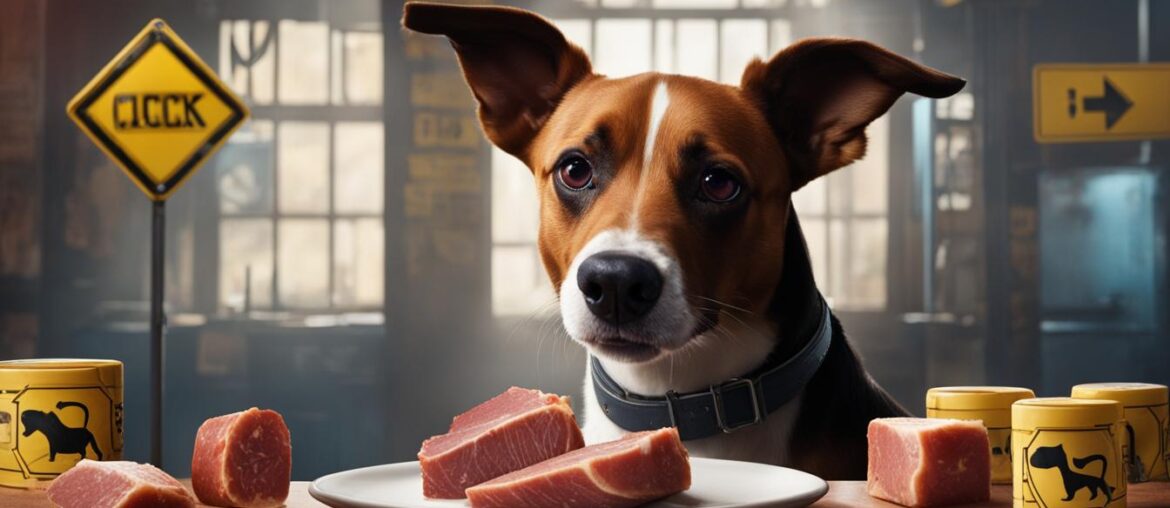When it comes to feeding our furry friends, it’s essential to ensure their safety and well-being. As a responsible dog owner, you may be wondering if it’s safe to give your dog a pork chop bone as a tasty treat. However, it’s important to understand the potential risks associated with feeding pork chop bones to dogs.
According to multiple sources, it is not safe for dogs to eat pork chop bones. Whether raw or cooked, pork bones can splinter and crack when chewed on by dogs, posing a risk of choking, intestinal blockages, and damage to the esophagus or intestines. These dangers make it advisable to avoid giving pork chop bones to dogs.
To help you make informed decisions about your dog’s diet and ensure their safety, let’s explore why pork bones are unsafe for dogs, alternative bone options, what to do if your dog eats a pork bone, and more. By understanding the risks and taking appropriate precautions, you can provide a healthy and enjoyable diet for your canine companion.
Key Takeaways:
- Feeding pork chop bones to dogs can pose a risk of choking, intestinal blockages, and internal injuries.
- Both raw and cooked pork bones can splinter and crack easily when chewed on by dogs.
- Consider safer alternatives such as large, raw cow bones or bison bones for dogs to chew on.
- If your dog accidentally eats a pork bone, closely monitor them for symptoms of intestinal blockage and seek veterinary attention if necessary.
- Always supervise dogs when given bones and consult with a veterinarian for personalized guidance.
Why Aren’t Pork Bones Safe for Dogs?
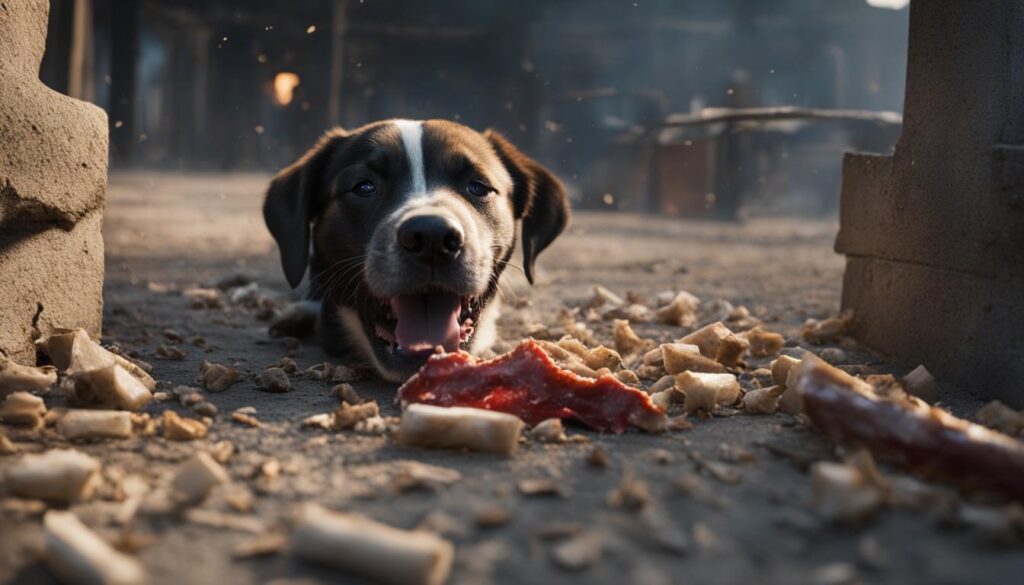
Pork bones, both raw and cooked, pose significant risks to dogs due to their tendency to splinter and crack when chewed on. These bones can lead to various health hazards, including choking, intestinal blockages, and damage to the esophagus or intestines. It is crucial to understand the dangers associated with giving pork bones to dogs and take necessary precautions to ensure their well-being.
One of the primary reasons why pork bones are unsafe for dogs is their propensity to splinter and crack. Dogs have powerful jaws, and their chewing motion can easily break pork bones into sharp fragments. These sharp pieces can become lodged in the throat or cause damage to the digestive tract when swallowed.
Furthermore, pork bones are relatively small compared to the size of a dog’s mouth, making it easier for larger dogs to swallow them whole. Once ingested, these bones can get stuck in the esophagus or cause blockages in the intestines, leading to severe complications that may require surgical intervention.
It is essential for dog owners to recognize the risks associated with giving pork bones to their pets and opt for safer alternatives that provide the necessary stimulation for their chewing needs.
If you are curious about the specific dangers of consuming pork bones for dogs, continue reading to learn more in the next section.
The Risks of Giving Pork Chop Bones to Dogs
The dangers of giving pork chop bones to dogs are significant and should not be underestimated. The following are some of the notable risks associated with feeding pork bones to dogs:
- Choking Hazard: The small size and brittle nature of pork bones increase the risk of choking, especially if they break into smaller pieces while being chewed on.
- Intestinal Blockage: If a dog swallows a large piece of pork bone, it can get lodged in their throat, esophagus, or cause blockages in the intestines, leading to severe discomfort and potential life-threatening situations.
- Internal Injuries: The sharp fragments of pork bones can cause cuts, tears, or punctures in a dog’s throat, esophagus, stomach, or intestines, which may result in internal bleeding or infection.
Given these risks, it is strongly advised to refrain from giving pork chop bones to dogs and prioritize their safety and well-being.
Are Any Bones Safe for Dogs to Eat?
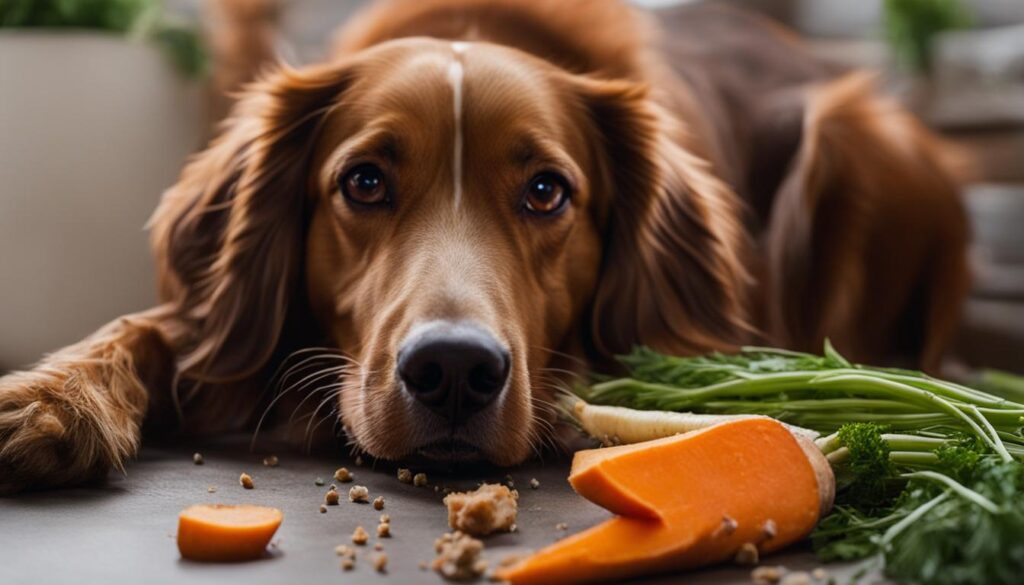
While pork bones are not safe for dogs to consume, there are other bones that can be safely given to them. Large, raw cow bones or bison bones are generally safe for dogs to chew on. It is important to ensure that the bone is large enough so that the dog cannot swallow it and that it is raw to avoid splintering. However, it is crucial to always supervise dogs when they are given bones to prevent any potential hazards.
Raw cow bones and bison bones provide dogs with a natural and healthy outlet for their chewing instincts. These bones are hard and durable, making them suitable for dogs to gnaw on for extended periods. Since these bones are not cooked, they are less likely to splinter and cause harm to the dog’s gastrointestinal tract.
When offering bones to your dog, it is important to choose a size that matches their breed and chewing strength. Small bones may pose a choking hazard, while bones that are too large can risk damage to the dog’s teeth or jaw. Opting for larger bones, such as femur bones or knuckle bones, ensures a safe and enjoyable chewing experience for your furry friend.
“Large, raw cow bones or bison bones are generally safe for dogs to chew on. It is important to ensure that the bone is large enough so that the dog cannot swallow it and that it is raw to avoid splintering.”
Supervision is key when giving bones to your dog. While these bones are safe to chew on, it is important to monitor your dog and intervene if they attempt to bite off or swallow large pieces. Additionally, if your dog is a strong chewer or has a history of dental issues, it is advisable to consult with your veterinarian before introducing bones into their diet.
Offering alternative bones to dogs not only provides them with an enjoyable chewing experience but also offers various benefits such as dental hygiene and mental stimulation. Chewing on bones helps to remove plaque and tartar buildup, promoting healthier teeth and gums. It also keeps dogs mentally engaged, reducing boredom and destructive behaviors.
In summary, while pork bones are not safe for dogs, large, raw cow bones or bison bones can be an excellent alternative for them to chew on. However, it is crucial to choose the right size and supervise your dog to prevent any potential hazards. Be sure to consult with your veterinarian for specific guidelines tailored to your dog’s needs and health condition.
What Should I Do if My Dog Eats a Pork Bone?

If your dog manages to eat a pork bone, immediate action is necessary to ensure their safety. If possible, remove the bone from their reach to prevent further ingestion. However, if your dog has already swallowed the bone or part of it, close monitoring is crucial. Watch for any symptoms that may indicate an intestinal blockage or other complications, such as:
- Vomiting
- Excessive drooling
- Abnormal bowel movements
- Lack of appetite
If you notice any of these signs, it is important to seek immediate veterinary attention. They will be able to assess your dog’s condition and determine the appropriate course of action.
Preventing Access to Pork Bones
“If your dog ingests a pork bone, it’s essential to act quickly and consult a veterinarian if symptoms of an intestinal blockage occur.”
To avoid these situations altogether, it is important to take precautions to prevent your dog from accessing pork bones. Make sure to dispose of any leftover bones in secure trash cans that are out of your dog’s reach. Additionally, educate your family and guests about the risks of giving pork bone scraps to dogs, emphasizing the potential dangers and the importance of keeping dogs away from them.
Remember, prevention is key when it comes to keeping your furry friend safe and healthy.
| What to do if your dog eats a pork bone: | What not to do if your dog eats a pork bone: |
|---|---|
| 1. Remove the bone from your dog’s reach. | 1. Do not induce vomiting without consulting a veterinarian. |
| 2. Monitor your dog for symptoms of an intestinal blockage. | 2. Do not ignore any signs of distress or discomfort. |
| 3. Seek immediate veterinary attention if symptoms occur. | 3. Do not give your dog any medication or home remedies without professional advice. |
| 4. Follow your vet’s instructions for further evaluation or treatment. | 4. Do not delay seeking veterinarian assistance. |
What Are Some Other Uses for Pork Bones?
While it is not recommended to give pork bones to dogs due to the safety risks involved, there are alternative ways to utilize these bones. One popular option is to repurpose pork bones to make a delicious and nutritious broth for dogs.
The broth can be easily prepared by simmering the pork bones in water for several hours, allowing the flavors and nutrients to infuse into the liquid. This broth can then be added to your dog’s food to enhance its taste and aroma.
Benefits of Pork Bone Broth for Dogs
Pork bone broth offers various benefits for dogs:
- Improved digestion: The gelatin released from the bones during the cooking process can help soothe and heal the digestive tract.
- Joint health: The collagen found in pork bones can promote joint health and alleviate symptoms of arthritis.
- Hydration: The broth can help keep your dog hydrated, especially during hot summer months when water intake may decrease.
- Appetite stimulant: The rich aroma and taste of the broth can stimulate the appetite of picky eaters or dogs recovering from illness.
However, it is important to note that not all dogs may tolerate pork bone broth well, especially those with digestive or dietary sensitivities. Therefore, it is recommended to consult with a veterinarian before incorporating broth into your dog’s diet.
| Benefits of Pork Bone Broth for Dogs | Precautions |
|---|---|
| Improved digestion | Consult with a veterinarian before adding broth to a dog’s diet if they have digestive issues. |
| Joint health | Monitor your dog for any adverse reactions or allergies after consuming the broth. |
| Hydration | Introduce the broth gradually to prevent stomach upset or diarrhea. |
| Appetite stimulant | Avoid using broth as a substitute for a balanced diet. It should be an occasional addition. |
Can Dogs Eat Cooked Pork?
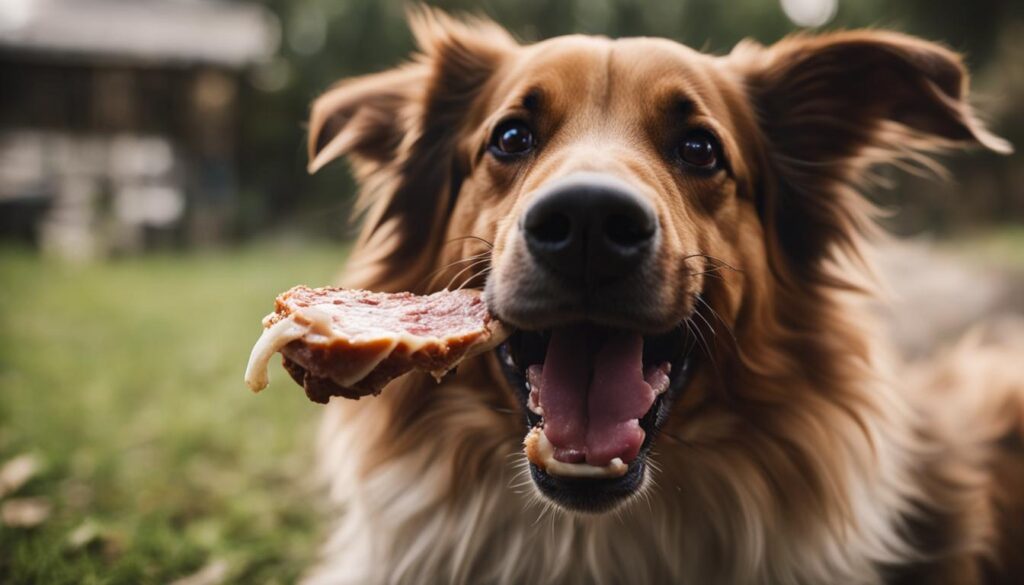
Dogs can eat cooked pork in moderation, but it is important to ensure that it is plain and free from seasonings or toxic ingredients such as onions or garlic. Cooked pork bones, however, should be avoided as they can splinter easily and cause harm to the dog’s mouth or internal organs. It is best to remove all bones from the cooked pork before feeding it to your dog.
Cooked pork is often enjoyed by humans due to its delicious flavors and succulent texture. However, certain precautions must be taken when considering including cooked pork in your dog’s diet. While plain cooked pork without any seasoning is generally safe for dogs to consume, it is crucial to understand and mitigate the potential risks.
Pork bones, whether raw or cooked, can pose significant dangers to dogs. Dogs have strong jaws and may easily crack or splinter bones when chewing on them. These sharp bone fragments can cause injuries to the mouth, throat, stomach, or intestines, potentially leading to choking, lacerations, or blockages in the digestive system.
To ensure your dog’s safety, it is important to remove all bones from the cooked pork before feeding it to your furry friend. Even small bone fragments can cause harm, so it is best to err on the side of caution. Instead of offering cooked pork bones as a treat, consider providing safer alternatives such as appropriate chew toys or specially formulated dog treats.
Here are some key points to remember regarding dogs and cooked pork:
- Plain and unseasoned cooked pork is generally safe for dogs to eat. However, moderation is key, as excessive consumption can lead to digestive issues or pancreatitis. It is always recommended to consult with your veterinarian about appropriate serving sizes for your specific dog.
- Avoid feeding cooked pork that contains toxic ingredients such as onions, garlic, or excessive amounts of salt. These can be harmful to dogs and may cause various health problems.
- Do not give your dog cooked pork bones, as they can splinter easily and cause injuries or blockages in the digestive tract. Ensure that any cooked pork you offer to your dog is boneless or free from bone fragments.
- Monitor your dog closely after feeding them cooked pork for any signs of discomfort, digestive issues, or unusual behavior. If you notice any adverse reactions, consult with your veterinarian promptly.
While dogs can safely enjoy cooked pork in moderation, it is essential to prioritize their health and well-being. Always consider the potential risks and take necessary precautions to ensure that the food you provide to your furry friend is safe and suitable for their consumption.
Can Dogs Eat Raw Pork?
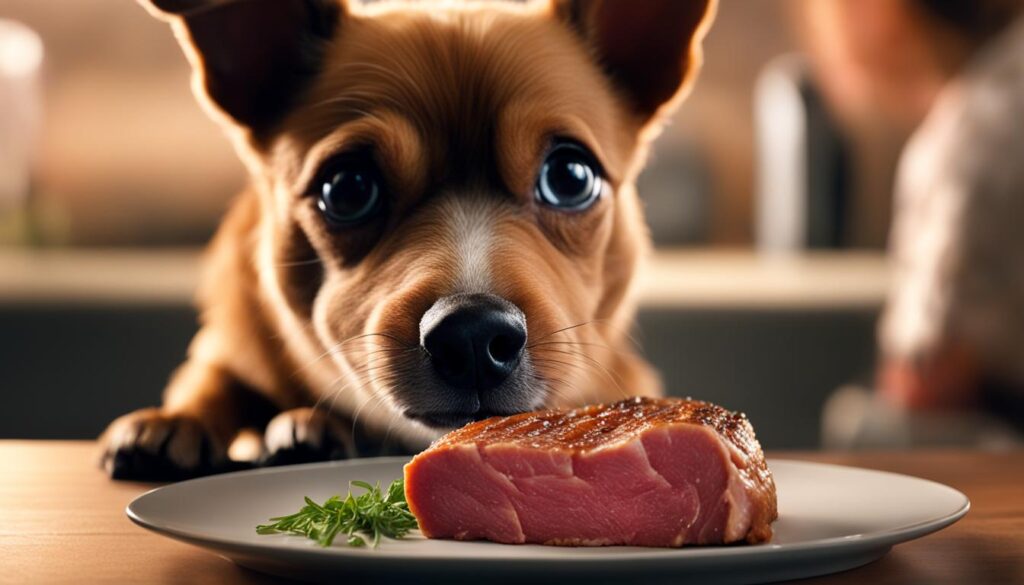
Feeding dogs raw pork is generally not recommended due to the potential risks involved. Raw pork meat may contain parasites such as trichinella, which can infect both dogs and humans. Additionally, there is a risk of contamination with harmful bacteria that can cause foodborne illnesses. To ensure the safety of your dog, it is best to cook pork thoroughly before offering it as a part of their diet.
Raw pork poses significant health hazards to dogs, making it essential to prioritize their well-being. Cooking pork not only helps eliminate parasites and bacteria but also makes it easier for dogs to digest. By thoroughly cooking pork, you can provide a safer and more nutritionally balanced meal for your canine companion.
If you’re considering feeding raw food to your dog, it is crucial to consult with a veterinarian who can offer specific guidance based on your dog’s individual needs and health condition. They can also help you explore alternative feeding options that prioritize your dog’s health and safety.
Benefits of Cooking Pork for Dogs
Cooking pork before feeding it to your dog offers several benefits:
- Eliminates parasites: Raw pork can contain parasites, such as trichinella, that can cause severe health issues in dogs. Cooking pork thoroughly helps to kill these parasites, reducing the risk of infection.
- Reduces bacterial contamination: Cooking pork at the appropriate temperature kills harmful bacteria that may be present, minimizing the chances of your dog experiencing foodborne illnesses.
- Aids digestion: Dogs have a shorter digestive tract compared to humans, making it more challenging for them to break down raw meat. Cooking pork helps to partially break down the proteins, making it easier for dogs to digest and absorb the nutrients.
Remember, the health and safety of your dog should always be the top priority. By cooking pork thoroughly, you can ensure that you’re providing a safe and nutritious diet for your furry friend.
| Raw Pork Risks for Dogs | Benefits of Cooking Pork for Dogs |
|---|---|
|
|
Can Dogs Eat Bacon and Ham?
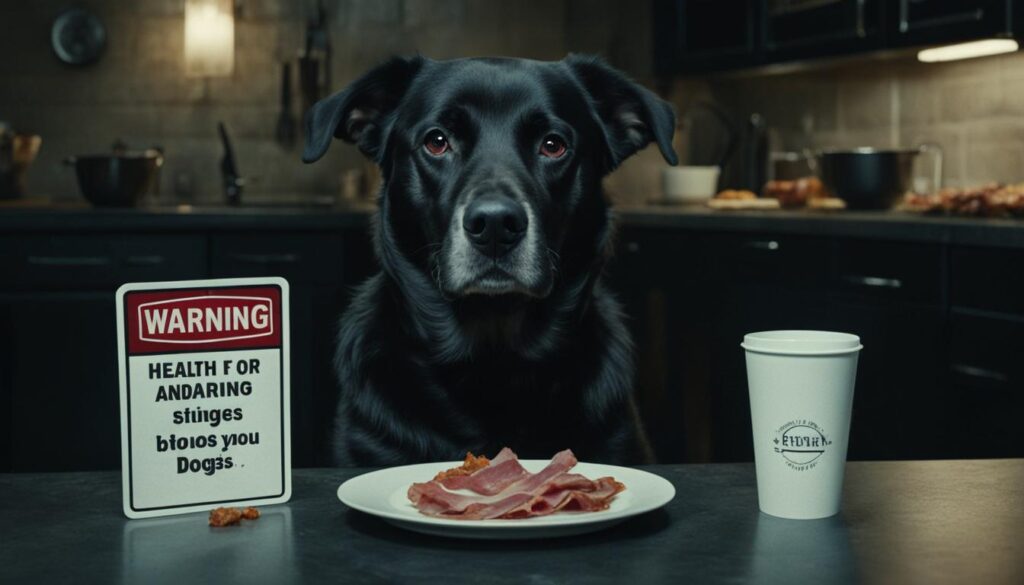
While dogs can enjoy the occasional indulgence of bacon and ham, it’s important to exercise caution due to their high fat and salt content. These beloved breakfast staples can pose risks to your furry friend’s health if consumed in large amounts or too frequently.
The main concern with bacon and ham is the high fat content. Just like in humans, excessive intake of fat can lead to pancreatitis in dogs. This condition causes inflammation in the pancreas and can result in severe abdominal pain, vomiting, and diarrhea. Pancreatitis is a serious condition that requires immediate veterinary attention.
The salt content in bacon and ham is another factor to consider. Dogs have lower tolerance for salt compared to humans, and excessive salt intake can lead to gastrointestinal upset and electrolyte imbalances. This can cause your dog to become dehydrated and may result in increased thirst, tremors, or even seizures.
It’s important to note that some hams are cured with nitrates or contain additional seasonings like garlic or onion powder, which are toxic to dogs. These ingredients can cause a condition called Heinz body anemia, which affects the red blood cells and can be potentially fatal. Therefore, it is crucial to ensure that any ham or bacon given to your dog is plain and free from seasonings, nitrates, and other harmful additives.
“While it might be tempting to share that sizzling strip of bacon with your pooch, it’s best to think twice and prioritize their health and well-being over their love for savory treats.”
It is recommended to limit the amount of bacon and ham given to dogs and only offer it on rare occasions. Additionally, it is crucial to consult with your veterinarian before introducing these foods into your dog’s diet, especially if they have any underlying health conditions or dietary restrictions.
Remember, a balanced and nutritious diet is essential for your dog’s overall health. While the occasional treat is fine, the majority of their food should consist of high-quality dog food that meets their specific nutritional needs.
How to Safely Give Dogs Bones
When giving dogs bones, it is important to follow certain precautions to ensure their safety. Here are some tips for giving dogs bones:
Choose Appropriate Bones
Choose large bones that are appropriate for the size of the dog to prevent choking hazards. Avoid small bones that the dog can easily swallow. Raw bones are generally safer than cooked bones, as cooked bones are more likely to splinter.
Supervise Your Dog
Never leave dogs unattended with bones. Supervision is crucial to prevent any potential problems. Keep an eye on how your dog chews and interacts with the bone to ensure they are safe while enjoying it.
Discard Completely Gnawed Bones
Once the bone has been thoroughly gnawed and there is no meat or tissue left, it is essential to discard the bone. Small pieces or fragments can pose a choking hazard or cause digestive issues if ingested.
Rotate Bone Types
To keep your dog interested and prevent boredom, it is recommended to rotate the types of bones you give them. Offer different options such as beef bones, lamb bones, or large synthetic bones. This variety will keep your dog engaged and satisfied.
Provide Fresh Water
After your dog has finished chewing on a bone, it is important to provide fresh water to help them stay hydrated. This will also help dislodge any small particles that may be stuck in their teeth.
| Bone Safety Tips | |
|---|---|
| Choose appropriate bones | Supervise your dog |
| Discard completely gnawed bones | Rotate bone types |
| Provide fresh water |
Wrapping Up
In conclusion, it is not safe for dogs to eat pork chop bones. These bones can splinter easily and pose a risk of choking, intestinal blockages, and internal injuries. It is recommended to avoid giving pork chop bones to dogs and instead offer safe alternatives, such as large, raw cow bones or bison bones. Always supervise dogs when giving them bones and consult with a veterinarian for more specific guidance based on the individual dog’s needs and health condition.
FAQ
Is It Safe for Dogs to Eat Pork Chop Bones?
No, it is not safe for dogs to eat pork chop bones. Pork bones, whether raw or cooked, can splinter and crack when chewed on by dogs, posing a risk of choking, intestinal blockages, and damage to the esophagus or intestines. It is advised to avoid giving pork chop bones to dogs due to these potential dangers.
Why Aren’t Pork Bones Safe for Dogs?
Pork bones, both raw and cooked, are likely to splinter and crack when dogs chew on them. This can lead to serious health risks such as choking, intestinal blockages, and damage to the esophagus or intestines. Additionally, pork bones are relatively small, making it easier for larger dogs to swallow them whole, posing a significant danger to their health.
Are Any Bones Safe for Dogs to Eat?
While pork bones are not safe for dogs to consume, there are other bones that can be safely given to them. Large, raw cow bones or bison bones are generally safe for dogs to chew on. It is important to ensure that the bone is large enough so that the dog cannot swallow it and that it is raw to avoid splintering. However, it is crucial to always supervise dogs when they are given bones to prevent any potential hazards.
What Should I Do if My Dog Eats a Pork Bone?
If a dog manages to eat a pork bone, it is important to take immediate action. If possible, the bone should be taken away to prevent further ingestion. However, if the dog has already swallowed the bone or part of it, close monitoring is necessary. Symptoms such as vomiting, excessive drooling, abnormal bowel movements, and lack of appetite may indicate an intestinal blockage, and immediate veterinary attention should be sought.
What Are Some Other Uses for Pork Bones?
Instead of giving pork bones to dogs, they can be repurposed to make a broth. The broth can be mixed with the dog’s food to add flavor. However, it is recommended to consult with a veterinarian, especially if the dog has digestive or dietary issues, before adding broth to their diet.
Can Dogs Eat Cooked Pork?
Dogs can eat cooked pork in moderation, but it is important to ensure that it is plain and free from seasonings or toxic ingredients such as onions or garlic. Cooked pork bones, however, should be avoided as they can splinter easily and cause harm to the dog’s mouth or internal organs.
Can Dogs Eat Raw Pork?
It is generally not recommended to feed dogs raw pork. Raw pork meat may contain parasites such as trichinella, which can infect both dogs and humans. Additionally, there is a risk of contamination with harmful bacteria. It is best to cook pork thoroughly before giving it to dogs to ensure their safety.
Can Dogs Eat Bacon and Ham?
While dogs can eat small amounts of bacon and ham as an occasional treat, it is important to be cautious due to their high fat and salt content. These foods can pose a risk of pancreatitis, upset stomach, and other health issues. It is best to limit the amount of bacon and ham given to dogs and consult with a veterinarian before doing so.
How to Safely Give Dogs Bones
When giving dogs bones, it is important to follow certain precautions to ensure their safety. Choose large bones that are appropriate for the size of the dog to prevent choking hazards. Do not leave dogs unattended with bones and discard completely gnawed bones to avoid any potential problems. It is also recommended to rotate the types of bones given to keep the dog interested and to prevent boredom. Additionally, it is important to provide fresh water after the dog has finished chewing on a bone to stay hydrated and dislodge any small particles stuck in their teeth.


